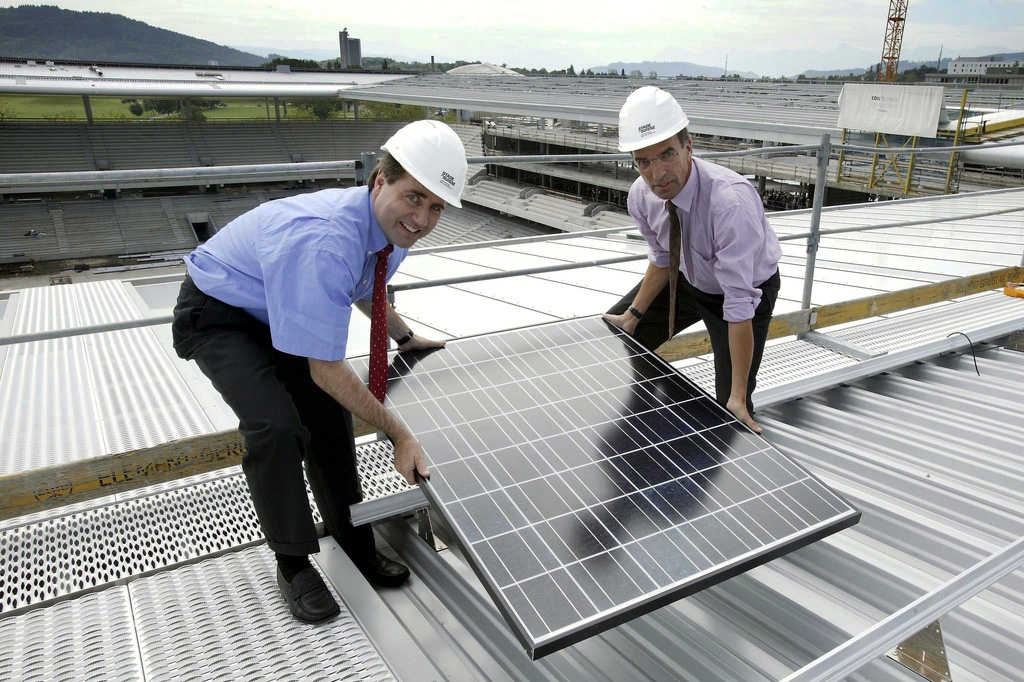Plan unveiled to boost cleantech sector

The government wants Switzerland to be a world leader in green technologies by 2020 and has unveiled a master plan to boost research and innovation.
Just which products could result from this can be seen in the Cleantech Expo, which reveals such Swiss inventions as eco-flush toilets and coffee machines powered by hydrogen.
The Cleantech Masterplan is designed to drive the government, the authorities, universities and the sector towards a greater emphasis on green technologies (see sidebar). It was announced by the new environment minister, Doris Leuthard, on November 4 at an Innovation Conference in the capital, Bern.
“The government’s recognition of the cleantech sector is very welcome,” said Maya Graf, a centre-left Green parliamentarian and organic farmer near Basel, who led the tour through the Cleantech Expo.
Under the plan, science and business will be brought more closely together – a development which Graf says is long overdue.
“We already pointed out that Switzerland was going backwards in the cleantech area ten years ago,” Graf told swissinfo.ch.
“This increases the gap between us and the world leaders, and leads to the potential for jobs in the area being lost.”
Doubts
Graf says a key point that is missing from the plan is changing consumer behaviour to become less wasteful. There is also a black hole regarding financing. “This will be a sticking point, because without this it won’t work,” she said.
Graf is pleased that the government wants to use more of an eco-style tax to push green technologies forward. But she still has some doubts.
“The parties on the political right have been blocking our proposals for greener taxes non-stop for 20 years,” said the politician.
In all there are 14 companies in the Cleantech in Switzerland exhibition, which was presented on the sidelines of the innovation conference. They offer a glimpse of a cleantech future.
The swissauto Wenko company has developed a power unit that can be used to boost the power in electric cars. A mini combustion engine powers a generator, which charges the batteries while the car is being driven.
“It is important that work on innovations like these prototypes is continued. This also brings know-how to Switzerland despite the fact that it doesn’t have its own car industry,” Graf explained.
Cold and hot drinks
A refrigerator developed by Awtec uses 30 per cent less energy than the models of the most efficient energy class A++. This is done with the aid of a speed-controlled rather than a constantly rotating compressor. It is only SFr50 ($51) more expensive than the current market leaders, say the developers.
“When we did our renovation work on our farm, we needed a new fridge,” said Graf, who regrets that the appliance is not yet on the market. She is convinced that the potential savings from electrical goods are enormous.
Graf is particularly pleased about the mobile coffee machine with hydrogen fuel cells developed by Ceka from Toggenburg near St Gallen. This will be in use in trains from next year. The hydrogen is placed in refillable bottles.
“I’m one of those Swiss Federal Railways customers who enjoys a coffee in the train,” Graf said. The hydrogen fuel cells ensure that thirsty customers are not deprived of a brew because the coffee machine’s batteries have run out of power, which can happen with the current models.
More good news: moving to this clean technology should not involve any extra costs – despite energy from hydrogen generally being more expensive. The money that would normally be spent on replacing the batteries could be used for the hydrogen, a company representative said.
Eco-loo
Another step in the right direction for Graf is Umtec’s “clever” toilet flushing system, to encourage less water usage. If fewer than six pieces of toilet roll are used, a smaller amount of water is automatically used for the flush. Rain water would be put to good use here, adds Graf.
Gramitech’s stand shows Graf an alternative for thermal insulation on her farm: the company makes insulation boards out of grass.
“Grass is a raw material that grows just about everywhere. We could have used grass that grew on our own land in our renovations,” Graf said, regretting that she had only just learned about the project.
Up to the 1980s Switzerland was a pioneer in promoting technology aimed at producing clean energy and photovoltaics.
However most companies closed down or moved abroad as a result of cuts in subsidies. The sector’s potential for innovation has been on the decrease since 2000, according to studies.
In a bid to reclaim lost ground the government has presented a programme aimed at taking the country back to the top of the list by 2020.
The plan includes 50 measures, partly to be implemented by the federal and by the cantonal authorities, to promote science and research on clean technologies and boost innovation.
The programme is subject to a consultation procedure before the government will approve the final version.
Last March the centre-left Social Democratic Party launched an initiative, backed by the Green Party and trade unions, calling on the government to encourage the move to renewable energies. Campaigners say the move would result in about 100,000 new jobs.
Around 160,000 people – 4.5% of the labour force – are working in Switzerland’s cleantech industry.
The sector created added value of about SFr20 billion ($20.6 billion) in 2008, the equivalent value of the tourism industry, according to the economics industry.
Cleantech exports reached about 15% of overall exports between 1996 to 2008, but their share has been dropping since.
(Translated from German by Isobel Leybold-Johnson)

In compliance with the JTI standards
More: SWI swissinfo.ch certified by the Journalism Trust Initiative













You can find an overview of ongoing debates with our journalists here . Please join us!
If you want to start a conversation about a topic raised in this article or want to report factual errors, email us at english@swissinfo.ch.